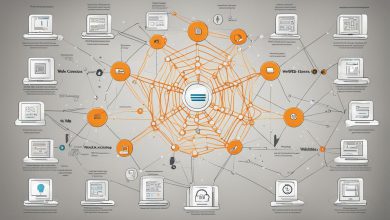
Welcome to our article on the importance of building security into every stage of your DevOps pipeline. In recent years, the DevOps approach has gained popularity in software development teams for its ability to break down silos and encourage collaboration between development and operations teams. However, with the increasing frequency and complexity of cyber attacks, it has become evident that security must also be an essential part of this process.
Shifting left is a DevSecOps approach that emphasizes the need for security to be integrated into every stage of the pipeline, starting from the earliest phases of development. This proactive approach ensures that security is not an afterthought but is instead built into the very fabric of the development and operations processes. By embracing this approach, teams can reduce the risks of potential security vulnerabilities and data breaches, and improve the overall quality of the software.
Key Takeaways
- Shifting left is a DevSecOps approach that emphasizes the integration of security into every stage of the pipeline, from development to operations.
- Building security into the pipeline from the earliest stages of development reduces the risk of potential vulnerabilities and data breaches.
- Shifting left improves the overall quality of the software and encourages collaboration between development, operations, and security teams.
What is DevSecOps?
DevSecOps is an approach to software development that integrates security into the entire DevOps process. All too often, security is treated as an afterthought in software development, causing delays and increasing the risk of security breaches. By adopting a DevSecOps approach, development, operations, and security teams can work collaboratively to ensure that security is built into every phase of the software development lifecycle.
Secure software development involves adhering to key principles, such as threat modeling, vulnerability management, and continuous security testing. By weaving security practices into each stage of the DevOps pipeline, developers can identify and remediate security issues early on, before they become costly and time-consuming to fix.
Adopting DevSecOps can bring many benefits, including improved agility, faster time-to-market, and reduced risk of security breaches. By establishing clear lines of communication and fostering a culture of collaboration, teams can work together more effectively to deliver high-quality, secure software.
Continuous Integration and Security
Continuous Integration (CI) is an essential part of the DevOps process, enabling teams to automate the integration of code changes into a shared repository. CI also allows teams to catch errors early in the development process, which can save time and money in the long run.
However, in order to ensure that the code being integrated is secure, it is important to include security testing as a part of the CI pipeline. This way, vulnerabilities can be discovered and addressed early on, reducing the risk of security incidents later down the line.
Vulnerability Management
Vulnerability management is a crucial aspect of secure software development and a key part of CI. By integrating vulnerability scans into the CI pipeline, teams can detect and prioritize potential vulnerabilities. This approach also enables teams to fix these vulnerabilities early on, thus reducing the risk of security incidents in the future.
It is also important to ensure that the team responsible for vulnerability management is well-informed and equipped with the necessary tools to address vulnerabilities effectively. This may include training on secure coding practices and familiarization with security testing tools.
Security Testing
In addition to vulnerability management, security testing should also be integrated into the CI pipeline. Security testing refers to the process of identifying potential vulnerabilities or weaknesses in software systems by simulating attacks.
There are different types of security testing, including static application security testing (SAST) and dynamic application security testing (DAST). SAST involves analyzing the code for potential vulnerabilities, while DAST involves testing the software in a live environment. Both types of testing can be automated and integrated into the CI pipeline, enabling teams to identify and address security issues early on.
When selecting an automated security testing tool, it is important to consider factors such as ease of use, scalability, and integration with other tools in the DevOps pipeline. It is also important to evaluate the accuracy and effectiveness of the tool, as false positives or false negatives can lead to wasted time and resources.
Security Best Practices for Development
Developers play a crucial role in ensuring the security of applications. By following secure coding practices, they can help prevent vulnerabilities that could be exploited by attackers. Here are some security best practices that should be followed during the development phase:
Secure Coding Practices
Secure coding practices involve designing and coding software with security in mind. Input validation, for example, is a crucial practice that can prevent many types of attacks. Developers should ensure that user input is validated for format, length, and type, and that special characters are sanitized to prevent injection attacks.
Another important practice is parameterized queries, which can prevent SQL injection attacks. Rather than concatenating user input directly into SQL queries, developers should use parameterized queries that separate the SQL code from user input.
Secure Configuration Management
Secure configuration management involves managing the configuration of software in a way that minimizes the risk of attack. Developers should ensure that software is configured with only the necessary features and services, and that these are secured through appropriate settings.
Secure configuration management also involves managing access controls and credentials. Developers should ensure that access controls are enforced throughout the application, and that credentials are protected from unauthorized access.
Code Reviews and Peer Testing
Code reviews and peer testing are important practices that can help identify security vulnerabilities. Developers should review each other’s code and test each other’s code for security issues. Peer testing can help identify issues that might otherwise be missed, and can help ensure that security is integrated throughout the development process.
By following these best practices, developers can help ensure that applications are secure from the outset. However, it is important to note that secure coding practices are just one part of a larger security strategy. To ensure that applications remain secure throughout their lifecycle, it is important to integrate security testing and monitoring throughout the DevOps pipeline.
Automated Security Scans and Testing
Integrating automated security scans and testing into the DevOps pipeline is a crucial step towards ensuring the security of your software. By automating security testing, you can identify vulnerabilities early on and reduce the risk of security breaches.
There are different types of security testing that you can integrate into your pipeline. Static application security testing (SAST) analyzes the source code to identify potential vulnerabilities, while dynamic application security testing (DAST) simulates attacks against running applications to identify weaknesses.
When selecting automated security tools, it’s essential to choose ones that suit your needs. Look for tools that support your programming languages and frameworks, and that integrate with your DevOps tools. You also want to ensure that the tools provide actionable results that your developers and security team can understand.
Automated security scans and testing should be an ongoing process throughout the development cycle. By performing regular security testing, you can ensure that your software remains secure as you make changes and as new threats emerge.
Secure Deployment and Release Management
In the DevOps pipeline, deployment and release management is a critical phase that requires adequate security controls to mitigate risks. Security and reliability should be top priorities, and all changes should undergo strict scrutiny before deployment.
One effective approach to achieve secure deployment is through the use of immutable infrastructure. This involves treating infrastructure like code and creating a new instance of the infrastructure with each deployment. This practice ensures that any changes are version-controlled and that only approved and tested changes are deployed.
Another essential step in secure deployment is to use secure build artifacts. This means that you must ensure that the build artifacts are free from vulnerabilities before deployment. This can be achieved by conducting vulnerability scans and security testing on the build artifacts before deployment.
It is also crucial to implement security controls during the deployment process. This includes ensuring that only authorized personnel have access to the deployment environment, implementing proper authentication and authorization controls, and encrypting sensitive data during transit and storage.
The secure software development lifecycle (SDLC) is another critical aspect of secure deployment. This methodology focuses on the integration of security controls throughout the entire software development process. It enables development teams to identify vulnerabilities early on in the development process and fix them before they become major issues.
By following best practices for secure deployment and release management, organizations can ensure that their deployments are secure and reliable. By shifting security left and integrating it into every stage of the pipeline, organizations can achieve a streamlined DevOps process that prioritizes both speed and security.
Conclusion
Building security into every stage of your DevOps pipeline is crucial in today’s rapidly evolving technology landscape. Shifting left is a fundamental concept that emphasizes incorporating security practices early in the development process.
Adopting a DevSecOps approach can help your organization foster collaboration between teams and enable you to deliver secure software at a faster pace. Continuous integration is an effective method to ensure security throughout the development process, and implementing security best practices during the development stage is critical in preventing security breaches.
Automated security scans and testing can help you catch vulnerabilities and mitigate risks, and incorporating security controls into your deployment process is essential in ensuring secure release management.
Take Action Today
As a copywriting journalist, I urge you to take action today to enhance your DevOps approach with solid security practices. Start by integrating security into your development pipeline and leveraging automated security scans and testing tools. Encourage collaboration between your development, operations, and security teams, and prioritize secure coding practices during the development stage.
By following these best practices, you can ensure the security of your software and protect your organization from potential security breaches. Remember, building security into every stage of your DevOps pipeline is a continuous process that requires ongoing effort and commitment, but the benefits of doing so are well worth it.
FAQ
Q: What is shifting left in the context of DevOps?
A: Shifting left refers to the practice of integrating security into every stage of the DevOps pipeline, starting from the earliest phases of development. It involves considering security requirements and implementing security controls early on, rather than waiting until later stages of the pipeline.
Q: Why is it important to build security into every stage of the pipeline?
A: Building security into every stage of the pipeline helps identify and address security vulnerabilities and risks early on, reducing the likelihood of security breaches. It also promotes collaboration between development, operations, and security teams, ensuring that security is a shared responsibility throughout the entire process.
Q: What is DevSecOps?
A: DevSecOps is the practice of integrating security into the DevOps process. It emphasizes the importance of incorporating security practices and principles into every stage of the pipeline, from development to deployment. DevSecOps aims to foster collaboration, automate security processes, and ensure that security is a integral part of the software development lifecycle.
Q: What are the benefits of adopting a DevSecOps approach?
A: Adopting a DevSecOps approach offers several benefits. It helps identify and address security vulnerabilities earlier, reducing the risk of security breaches. It also promotes collaboration between teams, improving communication and understanding of security requirements. By automating security processes and integrating security into the pipeline, DevSecOps can increase efficiency and speed up development cycles.
Q: How can continuous integration (CI) ensure security throughout the development process?
A: Continuous integration (CI) can help ensure security throughout the development process by integrating security testing and vulnerability management into the CI pipeline. This means that security checks and tests are performed automatically as part of the build process, allowing for early detection and resolution of security issues. It also facilitates the adoption of secure coding practices and promotes a culture of security awareness.
Q: What are some security best practices that should be followed during the development phase?
A: During the development phase, it is important to follow security best practices such as secure coding practices, secure configuration management, and code reviews. Secure coding practices include techniques like input validation and parameterized queries to prevent common vulnerabilities. Secure configuration management involves securely managing and storing sensitive information. Code reviews and peer testing help identify and address potential security vulnerabilities in the code.
Q: How can automated security scans and testing be integrated into the DevOps pipeline?
A: Automated security scans and testing can be integrated into the DevOps pipeline by incorporating tools and techniques that automatically scan for security vulnerabilities and perform security tests. This includes static application security testing (SAST) tools that analyze the application’s source code for potential vulnerabilities and dynamic application security testing (DAST) tools that simulate attacks on the running application to identify vulnerabilities.
Q: What are some recommendations for selecting and implementing automated security tools?
A: When selecting and implementing automated security tools, it is important to consider factors such as the tool’s capabilities, compatibility with your existing tools and systems, ease of use, and support. It is also important to regularly update and maintain the tools to ensure they remain effective against emerging security threats. Additionally, investing in employee training and education can help maximize the benefits of automated security tools.
Q: How can secure deployment and release management practices be implemented?
A: Secure deployment and release management practices can be implemented by incorporating security controls into the deployment process. This includes using secure build artifacts, employing secure configuration management, and implementing proper access controls for deployment environments. It is also important to ensure that security requirements are considered and tested during the release management process to minimize the risk of security vulnerabilities.
Q: What is the role of the secure software development lifecycle (SDLC) in ensuring secure deployments?
A: The secure software development lifecycle (SDLC) is a framework that helps ensure secure deployments by incorporating security practices into every phase of the software development process. It involves activities such as threat modeling, secure coding, security testing, and continuous monitoring. By following the SDLC, organizations can proactively address security threats and vulnerabilities throughout the development and deployment process.








